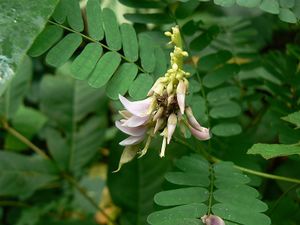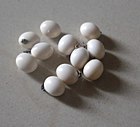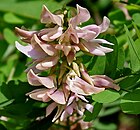Note: This is a project under development. The articles on this wiki are just being initiated and broadly incomplete. You can Help creating new pages.
Difference between revisions of "Abrus precatorius - Gunja"
(→How to plant/cultivate) |
(→Commonly seen growing in areas) |
||
| Line 56: | Line 56: | ||
==Commonly seen growing in areas== | ==Commonly seen growing in areas== | ||
| − | {{Commonly seen|Tropical area | + | {{Commonly seen|Tropical area}}, {{Commonly seen|Subtropical area}}. |
==Photo Gallery== | ==Photo Gallery== | ||
Revision as of 11:43, 4 April 2019
Abrus precatorius is a severely invasive plant in warm temperate to tropical regions, so much so that it has become effectively pantropical in distribution. It had been widely introduced by humans, and the brightly coloured and hard-shelled seeds had been spread by birds.
Contents
- 1 Uses
- 2 Parts Used
- 3 Chemical Composition
- 4 Common names
- 5 Properties
- 6 Habit
- 7 Identification
- 8 List of Ayurvedic medicine in which the herb is used
- 9 Where to get the saplings
- 10 Mode of Propagation
- 11 How to plant/cultivate
- 12 Commonly seen growing in areas
- 13 Photo Gallery
- 14 References
- 15 External Links
Uses
Blisters in mouths, Mouth sores, Bleeding piles, Leucorrhoea, Mild diabetes, Cough, Physical weakness, Ulcer, Urinary trouble, Snakebite, Infection in intestine.
Parts Used
Chemical Composition
Mature seeds contain alkali like abrine, precatorine, etc., abraline; toxalbumin like abrin I, II, III, etc., abrus agglutinin I, II (A. P. A Ⅰ, Ⅱ), sterols like abricin, squnalene, alcohol likeβ-amyrin, cycloartenol, 5β-cholanic acid, abrussic acid, sophoradiol, trimethyltryptophan abrusin galactose, arabinose, xylose, polysaccharide and flavonoids compounds, Seed covers contain gallic acid, abranin), delphinidin.[1]
Common names
| Language | Common name |
|---|---|
| Kannada | Gulaganji |
| Hindi | Gaungchi, Gunchi |
| Malayalam | Kunni, Kunnikkuru |
| Tamil | Gundumani, Kundumani |
| Telugu | Gurivinda or Guriginja |
| Marathi | NA |
| Gujarathi | NA |
| Punjabi | NA |
| Kashmiri | NA |
| Sanskrit | Gunja |
| English | Equirity |
Properties
Reference: Dravya - Substance, Rasa - Taste, Guna - Qualities, Veerya - Potency, Vipaka - Post-digesion effect, Karma - Pharmacological activity, Prabhava - Therepeutics.
Dravya
Rasa
Tikta (Bitter), Kashaya (Astringent)
Guna
Laghu (Light), Ruksha (Dry)
Veerya
Ushna (Hot)
Vipaka
Katu (Pungent)
Karma
Kapha, Vata
Prabhava
Habit
Identification
Leaf
| Kind | Shape | Feature |
|---|---|---|
| Paripinnate | Oblong | Leaf Arrangementis Alternate-spiral |
Flower
| Type | Size | Color and composition | Stamen | More information |
|---|---|---|---|---|
| Unisexual | 2-4cm long | pink/white | 9 | Flowering July to March in short axillary racemes |
Fruit
| Type | Size | Mass | Appearance | Seeds | More information |
|---|---|---|---|---|---|
| oblong pod | Thinly septate, pilose, wrinkled | seeds upto 5 | Fruiting throughout the year |
Other features
List of Ayurvedic medicine in which the herb is used
- Vishatinduka Taila as root juice extract
Where to get the saplings
Mode of Propagation
How to plant/cultivate
Commonly seen growing in areas
Tropical area, Subtropical area.
Photo Gallery
References
External Links
- Ayurvedic Herbs known to be helpful to treat Blisters in mouths
- Ayurvedic Herbs known to be helpful to treat Mouth sores
- Ayurvedic Herbs known to be helpful to treat Bleeding piles
- Ayurvedic Herbs known to be helpful to treat Leucorrhoea
- Ayurvedic Herbs known to be helpful to treat Mild diabetes
- Ayurvedic Herbs known to be helpful to treat Cough
- Ayurvedic Herbs known to be helpful to treat Physical weakness
- Ayurvedic Herbs known to be helpful to treat Ulcer
- Ayurvedic Herbs known to be helpful to treat Urinary trouble
- Ayurvedic Herbs known to be helpful to treat Snakebite
- Ayurvedic Herbs known to be helpful to treat Infection in intestine
- Herbs with Seeds used in medicine
- Herbs with Stem used in medicine
- Herbs with Leaves used in medicine
- Herbs with Roots used in medicine
- Herbs with common name in Kannada
- Herbs with common name in Hindi
- Herbs with common name in Malayalam
- Herbs with common name in Tamil
- Herbs with common name in Telugu
- Herbs with common name in Sanskrit
- Herbs with common name in English
- Habit - Deciduous climber
- Index of Plants which can be propagated by Seeds
- Herbs that are commonly seen in the region of Tropical area
- Herbs that are commonly seen in the region of Subtropical area
- Herbs





